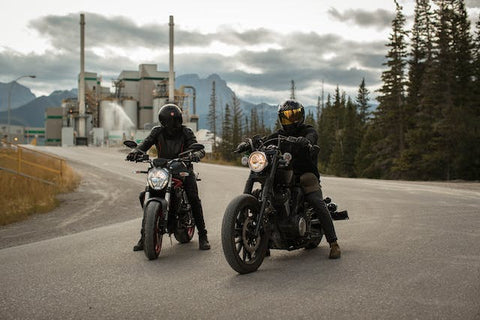Road safety is an issue of paramount importance that demands the attention of every road user. As per the National Highway Traffic Safety Administration, motorcyclists accounted for 14% of all traffic fatalities in 2019, a statistic that underlines the urgency to improve road safety measures.
As drivers and motorcyclists, it is our collective responsibility to ensure safe and harmonious cohabitation on our roads.
In this document, we seek to share valuable tips for both motorcyclists and drivers, to increase awareness, reduce accidents, and promote sharing the road responsibly. We will delve into important statistics, the significance of understanding each other's road behavior, and practical advice that could potentially save lives.
Consult an Accident Reconstruction Lawyer

In the unfortunate event of a traffic accident, enlisting legal support from an accident reconstruction lawyer can be invaluable. These professionals can help analyze the circumstances of the accident, determine liability, and guide you through the legal process to ensure your rights are preserved. Not only could an accident reconstruction lawyer help you recover damages, but they can also provide valuable insights on how the accident could have been prevented and what measures both motorcyclists and drivers can take to avoid similar incidents in the future.
Moreover, due to the nature of most motorcycling accidents and incidents, having a trusted legal advisor in your corner is essential to ensure that you receive the compensation you deserve. An accident reconstruction lawyer can effectively provide the necessary evidence and expert testimony to strongly support your case, especially in situations where there is a dispute of fault.
Keep a Safe Distance
This gives ample time to react to any sudden changes in traffic conditions or unexpected maneuvers from other road users. As a rule of thumb, keeping a minimum of two seconds distance between your motorcycle and the vehicle in front is recommended.
However, in adverse weather conditions or when traveling at higher speeds, this distance should be increased accordingly. On average, motorcycles require a shorter stopping distance than other vehicles, but this can change depending on the road conditions and bike speed. Riding a motorcycle can be thrilling, but it's important to always prioritize safety. This includes keeping a safe distance from other vehicles and navigating through tight spaces with caution.
It is important to maintain enough space in case of any sudden changes in traffic flow. Finally, motorcyclists should always avoid splitting lanes, as this act alone is dangerous enough to increase the risk of accidents.
Use Indicators
This alerts other drivers and motorcyclists of your intentions on the road, reducing the risk of collisions. Whether you are changing your lanes, making a simple turn, or deciding to merge in traffic, using the indicator will be the best and safest way to do so. In addition, it is important to use hand signals as well, especially in situations where other lights may not be visible or for extra precaution.
Drivers can also benefit from using their indicators more consistently and accurately. By providing motorcyclists with ample time to adapt and maintain safe distances, we can significantly improve the overall road experience for all, promoting smoother and safer travel. From a driver's perspective, using indicators can also prevent accidents caused by unpredictable or sudden lane changes.
Check Blind Spots Regularly
Motorcyclists, due to their smaller size, can easily go unnoticed in these blind spots. As such, it is important for drivers to be extra vigilant and check their mirrors and blind spots regularly. Similarly, motorcyclists should also pay close attention to blind spots of other vehicles on the road. This could potentially prevent accidents caused by a vehicle changing lanes or merging into traffic without noticing a motorcycle in its blind spot.
By being aware of each other's positioning on the road, both drivers and motorcyclists can contribute to a safer road environment and avoid potentially fatal accidents. For instance, motorcyclists should avoid riding in a car's blind spot for an extended period and keep moving to increase their visibility.
Wear Proper Safety Gear

This gear can significantly reduce the severity of injuries in the case of an accident.
Drivers should also be mindful of motorcyclists' safety and give them enough space to maneuver safely.
Furthermore, it is crucial for both parties to be mindful of prevailing weather conditions and make necessary adaptations accordingly.
It shouldn’t matter whether it is rain, high winds, or early morning fog, all of these conditions can significantly impair your visibility and increase the risk of accidents while you are on the road.
In these situations, drivers should slow down and give motorcyclists extra room while riders should take extra precautions and ride at a safe speed. Ultimately, by respecting each other's safety, we can create a safer and more enjoyable road experience for all.
Avoid Distractions
Distracted driving is a leading cause of accidents according to every statistic. Both drivers and motorcyclists should avoid using cell phones, adjusting the radio, or any other activity that takes their attention from the road. For drivers, this could mean missing a motorcycle in their blind spot or failing to see them approaching. For motorcyclists, distractions can lead to mistakes and put themselves and other road users at risk. It is important for everyone on the road to be fully focused and alert while driving or riding. Moreover, avoiding distractions allows us to better observe and understand each other's behavior on the road, promoting safer and more considerate driving habits.
Understand Each Other’s Limitations
For instance, motorcycles can stop more quickly than cars, but they also require more room to maneuver around obstacles. Drivers should avoid tailgating or following motorcycles too closely, as this can force riders into making sudden and dangerous maneuvers. On the other hand, motorcyclists should also be mindful of their own limitations and try to communicate them with other drivers. For example, if a motorcycle is unable to keep up with traffic or is riding at a slower pace, it should communicate this by using hand signals to indicate that other vehicles should pass. By understanding and respecting each other's limitations, we can coexist on the road safely and reduce the risk of accidents.
In conclusion, sharing the road responsibly requires awareness, education, and cooperation from all parties involved. By following these tips and being considerate of each other's safety, we can create a safer road environment for everyone. Additionally, continued education and awareness are crucial in promoting safe driving habits and reducing accidents. Let us all do our part to make the roads a safer place for ourselves and others, both as drivers and as motorcyclists. Remember, sharing the road is not just about following traffic laws, it's also about showing mutual respect and consideration for each other's safety. Let's work together towards a safer and more harmonious road experience
ABOUT THE AUTHOR
Fred Felton
Content Creator / Editor
Fred Felton is a copywriter, editor and social media specialist based in Durban, South Africa. He has over 20 years of experience in creating high end content. He has worked with some of the biggest brands in the world. Currently Fred specialises in the motorbiking adventure space, focussing on all types of biking both on and offroad. He is also a keynote speaker and has presented talks and workshops in South Africa.






